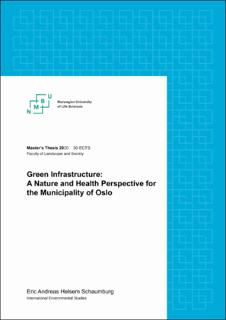| dc.contributor.advisor | Vedeld, Pål Olav | |
| dc.contributor.advisor | Vatn, Arild | |
| dc.contributor.advisor | Krog, Norun Hjertager | |
| dc.contributor.author | Schaumburg, Eric Andreas Helsem | |
| dc.coverage.spatial | Norway, Oslo | en_US |
| dc.date.accessioned | 2021-02-01T10:37:14Z | |
| dc.date.available | 2021-02-01T10:37:14Z | |
| dc.date.issued | 2020 | |
| dc.identifier.uri | https://hdl.handle.net/11250/2725526 | |
| dc.description.abstract | Oslo is a green city by both meanings of the word. The focus on sustainability and climate friendly politics are key components in the municipality’s plans and programs as well as Oslo being green in terms of having a lot of parks and greenspaces. Oslo enjoyed the title of the European Green Capital of 2019 and was awarded this title as a result of amongst other measures the management of its green and blue spaces. Coincidently there has in recent years been a lot of international research on the potential health benefits of exposure to nature encompassing many scientific fields and disciplines. As the literature on this broad topic of nature and health has been growing steadily there has not been a direct approach related to this perspective of nature and health in Oslo. That would seem to be a missed opportunity for a city and municipality that is otherwise doing so much in their sustainability efforts. For that reason, the objective of this thesis was to explore the scientific literature on the associations between nature and health, apply it to the context of Oslo to investigate how this perspective exists within the municipality and then provide recommendations for how this can be further accomplished.
To achieve this objective an overview of the literature was created through a literature review to the degree it was possible to include as much relevant research within the timescale and with the resources available. Further, an analysis of the documents most closely related to the topic of nature and health was performed to see to what extent a nature and health perspective exists within the plans and programs of the municipality of Oslo. The document analyses were further complimented by three semi-structured interviews with employees in the municipality that hold relevant positions to the topic to uncover potentially overlooked positions relevant to include. The thesis operates within the theoretical frameworks of the biophilia hypothesis, attention restoration theory (ART) and stress reduction theory (SRT). The theories seek to explain how the interaction between humans and their natural surroundings facilitate for improved or sustained physical and mental health and overall well-being. The research literature provides clues that are valuable for urban developers and politicians, but still needs to be integrated into plans and programs to be fully utilized. As such it is essential for the municipality of Oslo to integrate a nature and health perspective to further develop a healthy and sustainable home for its inhabitants. | en_US |
| dc.language.iso | eng | en_US |
| dc.publisher | Norwegian University of Life Sciences, Ås | en_US |
| dc.rights | Navngivelse 4.0 Internasjonal | * |
| dc.rights.uri | http://creativecommons.org/licenses/by/4.0/deed.no | * |
| dc.subject | Green infrastructure | en_US |
| dc.subject | nature and health perspective | en_US |
| dc.subject | public health | en_US |
| dc.subject | biophilia | en_US |
| dc.title | Green infrastructure : a nature and health perspective for the municipality of Oslo | en_US |
| dc.type | Master thesis | en_US |
| dc.description.localcode | M-IES | en_US |

